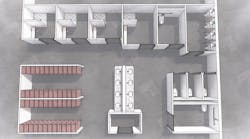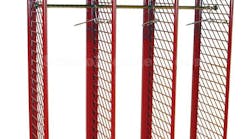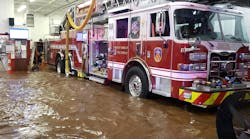Celanese Acetate, the company that produces PBI (polybenzimidazole) fiber, says firefighters have to pay more attention to how their gear is stored when it's not in action. A six-month nationwide study has found that ultraviolet rays from the sun weaken protective clothing.
How firefighting clothing is stored has a direct impact on its life and effectiveness as a protective tool, says Kim Henry, marketing representative for Celanese Acetate's PBI Products Division. "Improper storage in the sun degrades the fiber," says Henry. The breakdown occurs mainly as a result of UV exposure through windows as clothing hangs on racks and on the apparatus in firehouses. "We suggest that firefighters store protective clothing in lockers or garment bags," Henry urges.
PBI is a fiber that debuted in 1983. It is found in protective clothing including firefighting coats, bunker pants, hoods, SCBA strapping, gloves and even in aircraft seat fire blocking. The fabric is sold to mills that merge the fiber with other materials like Kevlar to produce clothing for many of the top fire gear manufacturers.
To drive home the point about protecting fire gear, Celanese Acetate conducted a test in cooperation with 10 departments in California, Arizona, Texas, Florida and Connecticut. Partici-pants in the Cross Country Ultraviolet Trial included the San Francisco Fire Department; Northwest Fire District in Tucson, AZ; Florida State Fire College in Ocala; and Simsbury Fire Depart-ment in Connecticut.
Fabric swatches were mounted on sheets of plywood and placed in non-shaded areas like rooftops and open fields. Included were PBI Gold (40% PBI/60% Kevlar), Advance (40% Nomex/60% Kevlar) and Nomex IIIA (95% Nomex/5% Kevlar).
Participating departments monitored and removed the samples at scheduled intervals - the samples were tested using the NFPA Trap Tear method in which the fabrics experienced degradation over time as they were exposed. Color changes early in the exposure period for the dyed fabrics signified that alterations were occurring in the garments. Graphs were constructed showing that the same general decrease in "tear strength" was experienced by all the fabrics tested.
The trial conducted in San Francisco used black dyed fabrics of PBI, Advance and Nomex. In general, fabrics dyed in black are usually better at absorbing UV than other colors. After one week in most locations, the change in the Advance and Nomex was obvious enough to tell the sun had adversely affected the fabric. One week of exposure on the PBI showed a mere darkening of the fabric, which in most cases was not an obvious indication that degradation was beginning.
Dos & Don'ts
Storage on hooks/racks in station bays. If windows are situated or bay doors are open such that gear receives sunlight exposure, the gear over time will start to show signs of degradation. The most commonly affected areas are the shoulders and tops and backs of coats. You should move the gear so it is not exposed to these conditions, or add a shield to cover the gear as it is being stored.
Storage on apparatus. If gear is being stored on an apparatus, fabric degradation will occur over time on those areas of a garment receiving the UV rays. Gear should be stored in closed cabinets on rigs, or not stored on rigs at all. Laying a protective shield over the gear on the rig is an option.
Storage in personal vehicles. Laying gear in vehicles so it is exposed for extended periods of time in sunlight, even if windows are tinted, will cause degradation to the fabric. Trunks of cars can be used for storage. Gear bags are the best option for storage in areas of vehicles exposed to UV rays.
Storage in enclosed areas. This is probably the most ideal storage location for turnout gear. However, this type of storage may bring another source of UV light into the equation. Fluorescent lighting is another source of UV. However, studies on fluorescent lighting show its effects to be far less intense than that of sunlight over time.
While Celanese acknowledges that other conditions like "washing, wearing, chemical exposures, etc." contribute to a garment's overall "wear life," firefighters need to be concerned over storage. The fabrics tested during the trial were exposed during the summer months when UV conditions were most extreme. Garments worn during normal firefighting and EMS activities that include periodic exposures to the sun and that are combined with proper gear maintenance and storage will not affect a garment's strength to the levels so quickly seen in this trial.
For further information contact the PBI Products Division of Celanese at 704-554-3378.
Joseph Louderback, a Firehouse® contributing editor, served as editor of the FDNY's Publications Unit and as a government affairs reporter. He is a 20-year member of the Milmont Fire Company in Milmont Park, PA, and conducts media relations programs for the fire service.




